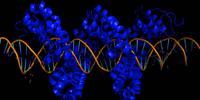Research
Sugar + phosphate + nucleobase. It’s amazing what these three simple components can do. As chemists, we modify all three of these components to produce nucleic acids with improved stability, potency and specificity for therapeutic applications.
We make antisense oligonucleotides, siRNAs, single-stranded siRNAs, aptamers, and conjugates. We synthesize and study a number of proven chemistries including peptide nucleic acid and locked nucleic acid, as well as new analogues that we design for specific tasks.
![]()
Silencing of nuclear RNAs (including nuclear-retained mRNAs, IncRNAs and eRNAs). In collaboration with Hans Michael Haitchi at the University of Southampton, we discovered that the asthma susceptibility gene ADAM33 can be readily silenced by LNA gapmer antisense oligonucleotides, while siRNAs or ss-siRNAs lead to a much poorer knockdown. This result is likely related to the fact that ADAM33 is largely retained in the nucleus and readily accessible for silencing via the RNase H mechanism. Similarly, we were surprised to find (with T K Kim's lab at the University of Texas Southwestern) that even transiently expressed enhancer RNAs (eRNAs) can be silenced by LNA gapmers. We continue to explore silencing of nuclear RNA targets of various types.
![]()
AptaMIPs and OligoMIPs. In collaboration with Nick Turner’s lab at the Open University, we developed AptaMIPs and OligoMIPs, molecularly imprinted oligonucleotide-polymer hybrids that show enhanced stability and maintain the binding of the parent oligomer.
![]()
In the pipeline. There are also a few projects that are too early for us to tell the Internet about yet. (We’ll let you know the details as soon as we can).
- new ways to modify guide RNAs for CRISPR/Cas9 genome editing
- a chemical approach to facilitate the synthesis of long DNA for synthetic biology
- novel fluorescent nucleobases
- new approaches in the area of oligonucleotide delivery
